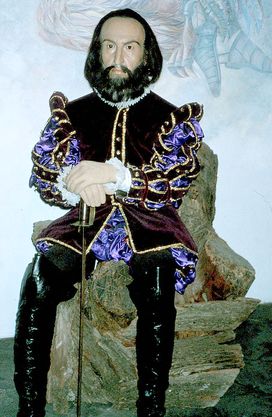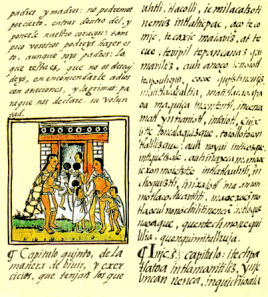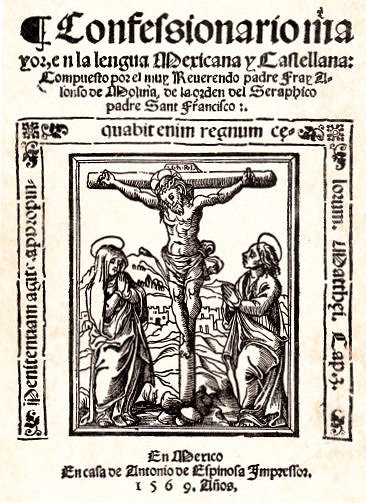Content created: 2008-08-21
Part 20
Part 22
The Aztecs: A Tributary Empire (21)
Critical Appendix I: Our Sources
36. The only full-fledged pre-Columbian script in the Americas was Maya, which was, however, extremely inefficient and difficult, and did not spread to other areas. The level of abstraction and conventionalization in the Náhuatl "script" (and even more so in Zapotec "script") was quite advanced, and some pictures had already come to stand for the sounds of the words they represented rather than for the objects represented by the pictures. Quite probably, given additional time, the system would have evolved into a reasonably functional syllabary with a lineal ordering of arbitrary sound signs representing spoken language. It leapfrogged that stage when it was replaced by Roman letters with the arrival of the Spanish.
Nahua speakers had no efficient way to write Náhuatl before it was rendered in Roman letters by early Spanish settlers. Some written records were kept, in which pictures (sometimes highly abstracted and conventionalized ones) were used to compose place glyphs or name glyphs, but it was not possible to write a love letter or a law code or a university examination using this script. [Note 36]
About 1430 the Aztec régime seized and burned all of the picture-books in conquered towns in order to eliminate histories or myths that might contradict their own versions; from that time on, sacking a town inevitably also meant destroying its documents. [Note 37]
A second major book burning occurred shortly after the Spanish conquest not quite a hundred years later. Very few records survived this conflagration, although Spanish policy shortly thereafter actively encouraged historical research.
37. We do not have any document that can reasonably be described as "the official history" of the Aztecs, but something like that seems to have existed and to have been known to some early Spanish writers. R.C. Padden (1967:55) argues that it is perhaps well represented by the compiler of the Codex Ramírez, who appears to have (mis-)taken it as a serious work of real history, rather than a propaganda piece.
However, we have surprisingly rich textual material composed after the Spanish conquest, both by Spaniards interested in the Aztec world (who wrote in both Spanish and Latin), and by Nahua who survived the conquest or were descended from members of the Aztec aristocracy, eager to "set the record straight" about the comparative glories of their ancestors. Most of the Nahua wrote in Náhuatl using Roman letters.

Cortés is represented in this wax museum exhibit with his hair perfectly combed and his garments of silk and velvet beautifully cleaned and pressed. There were probably very few moments in his life when he looked this way. But for all the brutality of the Spanish conquest of Mexico, he
was a thoughtful and educated man, and his account and those of his companions provide important historical information and insights about the Aztec world.
In Spanish, the diary of Hernán Cortés, Mexico's conqueror himself, is preserved, as are the writings of several observant members of his entourage (notably Bernal Díaz del Castillo [1492-1584], author of La Conquista de México) or Spaniards who came to Mexico shortly after the conquest (such as Bartolomé de las Casas [1484-1556], whose Brevísima Relación de la Destrucción de las Indias in 1552 was important in bringing the plight of conquered New Spain to the attention of European readers).
The term "codex" refers loosely to an early manuscript, whether or not it is recorded in a true written language. For example, the Boturini Codex (more commonly known as the Tira de la Peregrinación) represents the migration of the Mexica from the north using the picture system that was the best pre-Spanish notation available at the time. Our copy dates from the mid-1500s (and has a few Spanish marginalia), but seems to follow an earlier version.
Náhuatl authors, often with Spanish "Christian" names, included Fernando Alvarado Tezozómoc (Crónica Mexicáyotl) and Fernando de Alva Ixtlilxóchitl, a descendent of the rulers of Tetzcóhco, one of the towns of the central Aztec "Triple Alliance" (Historia Chichimeca). The Codex Chimalpáhin, acquired by Cambridge University in 1827 but only identified in 1983, is a collection of materials in written Náhuatl assembled by Domingo de San Antón Muñón Chimpáhin-Quauhtlehuanítzin. It consists mostly of a chronology and of the genealogies of important Aztecs (which obviously mattered to the author because some of them were, after all, his royal ancestors). Among the authors included in it is the same Fernando de Alva Ixtlilxóchitl just mentioned.

Lacking a full writing system, the Aztecs nevertheless developed the use of place glyphs and other conventionalized symbols to a very considerable level, producing "books" that served as an aide-mémoire in telling fortunes, collecting tribute, or even recounting history, as in the famous
Tria de la Peregrinación, recopied and annotated in Spanish after the Conquest.
The Codex Chimalpopóca is made up of two documents, the "Annals of Cuauhtítlan" (Xiuhpohuálli, literally the "year count") and the "Legend of the Suns" (Tlamachiliz-tlatolzazanílli, literally "wisdom tales").
Not all of the codices are concerned with history and myth, of course. For example, the Codex Badianus, now in the Vatican Library, contains a wealth of information about Aztec herbal healing. We even have poems by several different writers, the most famous being King Nezahual-cóyotl (1402-1472), ruler of Tetzcóhco, and his son and successor Nezahual-pílli (1464-1515), written down from memory after the Spanish brought writing. (Examples are included in the "Aztec Folio" associated with this essay. Link) [Note 38]
Return to top.
38. Aztec poems were written by both men and women, but in a great many cases we no longer know the name of the author of a given poem. Of female poets, only one is known by name, a certain Macuilxóchitl, none other than the daughter of Tlacahélel, the "woman snake" so central to this essay. In it she piously gives thanks for the Aztec conquest of other territories.
Not all early Mexican writers used Náhuatl or lived before the Conquest, but some remain critical resources about pre-conquest Nahua life. Francisco Javier Clavijero (1731-1787) was a Mexican-born Jesuit of Spanish descent from Veracruz who, like other Jesuits, was expelled from Mexico in 1767 by royal decree. He took refuge in Italy, where, in 1780, he published his Historia Antigua de México some 250 years after the conquest, but based on long and careful study of sources now largely lost to us. Like most "Spanish boys" of his era in Mexico, the young Clavijero had grown up bilingual in Spanish and Náhuatl.
The Jesuit José de Acosta (1539-1600), who spent 16 years in Peru and seems to have learned both Quechua and Aymara, the two most widespread languages, produced a substantial work —the English translation runs to about 800 pages— Historia Natural y Moral de las Indias (1590) which sought to provide a detailed survey of the Americas for a readership in Spain. He is known today as one of the first people to propose (correctly) the peopling of the Americas from Asia (although he did not know about the Bering Strait). Among its detailed descriptions of the Aztec and Inca worlds Acosta seeks to include as much pre-Conquest material as he can feel confident about.

Part of a page from Bernardino de Sahagún's
Historia General de las Cosas de Nueva España — the Florentine Codex. The bilingual text and many pictures made this the cornerstone of Aztec studies.
By far the most important of our early sources is the Florentine Codex (Historia General de las Cosas de Nueva España), a massive work assembled by the Franciscan missionary Bernardino de Sahagún, between 1540 and 1585, building on the earlier work of a fellow Franciscan, Andrés de Omos, a brilliant polyglot who had been commissioned in 1533 —a dozen years after the fall of Tenochtitlan— to develop a (now lost) comprehensive history of Mexico from native "manuscript" sources.
Sahagún interviewed Aztec survivors and recorded their remarks in Náhuatl more or less verbatim. He then had his assistants illustrate them with about 1,800 sketches. (He provided some Spanish translations, but the first full Spanish edition appeared only in 1830.) The fascinating pictures, some monochrome on the model of European engravings of the period and some in color, give as much insight into Aztec life as the text. In a meticulous study, Diana Magaloni Kerpel (2014) has shown that even the selection of alternative coloring matter sometimes seems to reflect the artists’ attitudes toward their subjects

The massive Nahuatl dictionary compiled by Alfonso de Molina (1513± - 1585±) is still in print over 400 years later. Shown here is the 2004 printing.
Sahagún’s massive project must have seemed especially important when a major epidemic swept over central Mexico in 1576, about half a century after the Spanish arrival, and there seemed a real risk that none would live to see the finished work except future discoverers.
Early colonial wills, censuses, land records, and town council minutes have sometimes been preserved, giving us insights into life immediately after the Conquest, often with information that extends backward into the Aztec period.
Some of our information even comes from early dictionaries. Since Náhuatl was the lingua franca of the most important regions of Mexico, the Spanish early set out to learn it, and the early dictionaries and grammars they compiled are rich in proverbs, idiomatic phrases, and explanations of the semantic fields of terms. The fullest is by Alonso de Molina, whose extensive dictionary was composed somewhere between 1555 and 1571 —about the time Shakespeare was born— and is still in print today.

Alfonso de Molina may have regarded his
Confesionario Mayor en la Lengua Mexica y Castellana as more central to his missionary goals, but his notes on Classical Nahuatl grammar and usage, and especially his extensive dictionary, still in print today, provided the basis for much of our understanding of that language.
Similarities among some sources suggest that their authors, including Durán and Acosta, borrowed from a common text no longer known to us and sometimes referred to as Crónica-X. It is, of course, not impossible that additional XVIth-century text material may turn up from some unexpected quarter to deepen our understanding of late pre-Conquest and early post-Conquest America.
Naturally care must be taken to assess the reliability of each source, and specialists differ in the extent to which they find different early authors to be engaged in self-serving assessments of Aztec life and history. For example, a 2008 study of the reputation of the poet-king Nezahual-cóyotl argues that traditional accounts of him may have been biased to favor Spanish colonialism and Judeo-Christian perspectives on Mexican history (Lee 2008). On the other hand, there is also a risk of modern dismissal (debunking) of early authors only because they do not approach history from our own perspective.
Because of this wonderfully full historical record, and because of the short period during which the Aztec régime held sway —about a century and a half from about 1370 to the Spanish arrival in 1519— it is possible to give almost a blow-by-blow account of its history, complete with royal genealogies, names of individual players, and a reasonable description of many of the institutions and events of the Aztec world. This can, of course, become an embarrassment of riches, and the many known names and specialized Náhuatl terms can easily become overwhelming, even if they are the envy of specialists in other ancient societies. In this account, I have tried to simplify the picture insofar as possible by adding English translations and by hyphenating long words. There is also a glossary linked at the top of each page. Still, it is well to have a quick overview of the Náhuatl language. That is the project of Appendix II (Part 22).
Return to top.




